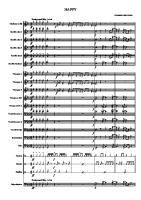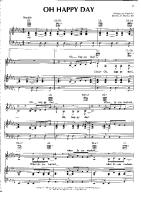Dont Worry Be Happy Guitar Thomas Leeb (Vomit) [PDF]
Tablature Atlas At this point in time there is no definite way to commit this style of guitar music to paper. The approa
46 0 1MB
Papiere empfehlen
![Dont Worry Be Happy Guitar Thomas Leeb (Vomit) [PDF]](https://vdoc.tips/img/200x200/dont-worry-be-happy-guitar-thomas-leeb-vomit.jpg)
- Author / Uploaded
- mangel Tis
Datei wird geladen, bitte warten...
Zitiervorschau
Tablature Atlas At this point in time there is no definite way to commit this style of guitar music to paper. The approach I have taken here is the result of almost a decade of transcribing guitar music and receiving feedback from students and colleagues. The result is supposed to be as self-explanatory as possible and the performance notes for each pi e will cover the fine print. If you find a better way to do this, please do get in touch.
Explanation of Symbols The Colour Whenever you see green, use your right hand . Whenever you see black, use your left hand.
The X If you see an X, you get to hit something. The performance notes will tell you where to aim.
The diamond Diamonds represent harmonics. Regular Iiarmonics are notated using a number on tablature with a diamond o n top. 'Artificial' harmonics are shown with the fretted note in black with a diamond and the node point fret number in brackets on top.
The Slur
Every time you see two numbers connected 6ya slur, you are looking at either a hammer-on or a pull-off. Which of the two depends on which number is larger. Single slurs will generally be used if adjacent strings are involved at the same time.
Combinations You might run into hybrids between the above symbols. A slapped harmonic will be shown as a diamond/X combination or you might run into a harmonic resulting from a pull-off. Refer to the performance notes for detail s.
Don't Worry, Be Happy This song was written by Bobby McFerrin and I've loved it at first 'sight' ! I've been meaning to do an arrangement of this for a long time but all the avenues I went down came up empty . When somebody showed me DADF#AE tuning the arrangement pretty much wrote itself and all it took was the partial capo trick to make the bass thicker. You'll put a capo across the top five strings on the third fret. Just leave the bass string free and tune it an octave lower than the fifth string . I'd really like to recommend "Transcribe"! a tool you can use to slow down and/or repeat certain sections you mark. You f an p lace markers with notes and even have a video open. This will enable you to follow exactly what's going o n frame by frame.
Performance Notes Bar 2 In the middle of this bar you'll need to switch the fingers with which you play the left-hand chords in order to be able to pl ay die bass notes. I found it very hard to get my head around this o ne so give yourself some time as well! The third fret on the fifth string earlier one is played with your middle finger and the second fret on the same string later on is the index finger. I'll let you figure out which fingers to use for the chords - there's only one good choice anyway.
Bar 6 The green Xs o n the third string stand for whacking the side of your right thumb joint against the neck of the guitar: Thanks, Michael Hedges!
Bar 8 Time for scratching! I love adding a percussive scratch here and there. Scratch down the body of your guitar, just below t he fretboard. Scratch plate recommended!.
Bar 13 More scratching: tuck your middle and ring finger into the base of your thumb (similar to making a fist, just without the thumb and small finger). Starting with the ring finger, release this explosively against the scratch plate.
Bar 14
The black X on the second string is a left-hand slap to the lower shoulder of the guitar. I hope you don't have a pointy cutaway! As always, the green X on the bass string is a heel-of-the-right hand thump, giving a nice bass drum sound. Watch this one though, it's easy to overpower the rest of the tune with this. The green X on the fourth string stands for a right hand tap on the upper bout above the fretboard and last, but not least, the green X on the third string is a right hand thumb slap against the side of the guitar. which should so und a bit like a conga slap.
Bar 15 A technique I borrowed from Michael Chapdelaine: it consists of a right-hand strum (shown by the little green arrow) at the same time as a right thumb-click on to the strings (shown by the green X on the fifth string). Took me a while and I'm still not too good at it. I hope you're better at this than me!









